On Tuesday, I attended the FDA Biotech Education and Outreach public meeting in San Francisco, and here is my experience participating in this public event. I was happy to be able to make a comment on behalf of Biology Fortified, and the feedback I received was very helpful and gave us guidance on what the FDA wants to know more about. There were some new and fresh voices who provided useful information, as well as familiar faces from groups opposed to biotechnology who provided some comments worth paying attention to, as well as clearly false information worth responding to. And of course, there were a few characters who went beyond misunderstanding the purpose of the meeting and instead promoted their products, conspiracy theories, and the concerns people expressed showed the FDA representatives how deeply problematic this topic has become in the last couple decades.
Getting there
First, it is very difficult for anyone to be able to attend and participate in such meetings. Held on weekdays, and downtown in major cities, the room that could have fit a couple hundred people had closer to 30. People have work, there is the long commute through heavy traffic (especially to get to San Francisco), various costs involved, and also takes preparation. I was joined by Chad Niederhuth, who drove all the way from Sacramento that morning to give a comment, and Zen Honeycutt and Yvette d’Entremont had signed up but did not attend. Anyone who manages to make it to these meetings is a rare exception, and it skews the kinds of comments and perspectives that our government can get. Nevertheless, it is an important way for our government to hear from its citizenry, and I was happy to see many diverse voices in attendance, including those with which I may disagree.
Myself, it was quite a squeeze to be a part of this. I spent the weekend with family in Los Angeles, and drove home Monday, only to eat dinner and immediately continue to San Francisco. Parking in the east bay, I took BART into the city and stayed in the cheapest hotel I could find, a couple blocks away from the event location. I was only able to do this because of our sustaining members, because unlike some of the organizations on either side of the biotechnology debate, we do not have the deep pockets of industry and ideological organizations backing us. The more support we can get, the more you will see us being able to take the time to get involved!
Voices new and old
The people who signed up to give oral comments were an interesting and diverse group, with some new voices who added some fresh perspectives. The first comment was made by Daniel Westcott, a graduate student at UC Berkeley, who talked about their science communication efforts in the CLEAR program, and spoke about false dichotomies between areas of agriculture like with biotech and organic. Lynn McBride, from the California Farmer’s Union recommended reaching out to farmers and talking about impacts on the farm. James Allison is a high school teacher who came all the way from Loveland, Ohio, and he shared his experiences developing curricula for students in high schools and suggested that the FDA consider that as one route for their communication efforts.
Stephan Herrera, from Evolva, Inc., recommended creating materials to complement food labeling laws so that the public does not perceive that biotech-derived foods have safety issues, create “Perception vs Reality” documents, and hold challenges for students to create their own videos about food facts. He also emphasized the need for the FDA to understand and employ Search Engine Optimization (SEO) so that their pages can be found by the public. Chad Niederhuth also added that the FDA should base their science communication efforts on science-based recommendations so that they know that they will have an impact.
There were some familiar organizations that campaign against biotechnology who were in attendance and delivered comments as well. Dana Perls from Friends of the Earth gave many critical comments about genetically engineered crops, and directly attacked the scientific consensus on the safety of consuming the genetically engineered crops that are on the market, calling it a “false generalization.” Lisa Ermo, representing Moms Across America, claimed that genetically engineered foods are lower in nutrients (they are not), but mainly spoke about glyphosate in the herbicide Roundup.
There was one familiar voice who signed up to speak in-person who was a welcome addition to the public comments. Peggy Lemaux, a professor at UC Berkeley, was the last person to comment. She told the story of the ice-minus bacteria and how lack of public engagement contributed to poor perceptions, along with researchers wearing suits that “looked like a toxic waste cleanup.” She stressed the importance of university extension programs, and surveying the public’s questions and concerns to figure out what to communicate to them about the technology.
Lawyer Lawyer
The comments from the Center for Food Safety representative, Rebecca Spector, deserve much more attention. Read like they were drafted by lawyers, they also hint at the various ways that the anti-GMO law firm may work to attack and undermine any outreach program from the FDA. For instance, Spector suggested that the “FDA should not communicate anything that is contradicted by agency statements.” As an example, she cited an oft-repeated claim that the USDA said that DroughtGard, a Monsanto GE corn variety engineered for drought tolerance was found by the USDA to be “inferior to conventional breeding” and that it wasn’t any more drought tolerant than other varieties of corn. This is based on a USDA regulatory document (Finding of No Significant Impact, page 33) that said that there are other drought-tolerant corn varieties in different genetic backgrounds that have similar tolerance to drought. It is widely misinterpreted to mean that the drought tolerance doesn’t work, or in this case, claim that it is inferior, but the USDA did not conclude that at all. What is important to remember is that this is a single gene that can confer drought tolerance in almost any genetic background, and can be used in breeding to achieve that trait irrespective of the other traits in the variety. It is a useful advancement, and it protects some of the yield during moderate drought. The Center for Food Safety is misrepresenting the USDA’s comments.
To put it another way, let’s say you engineered a granny smith apple to have a red skin. There are other apples with other genetic backgrounds (other flavors, shapes, sizes, etc) that also have red skin. But this apple is now red with a previously non-red genetic background of the granny smith. The USDA deregulates this red-skinned granny smith and mentions “It is prudent to note that red apple skin is also present in other genetic backgrounds and this new variety does not exceed the redness found in these other varieties.” The Center for Food Safety then reports that genetic engineering is inferior to breeding, that the USDA says it doesn’t work, and the FDA should not be allowed to say that the genetically engineered red-skinned apple is in fact… red.
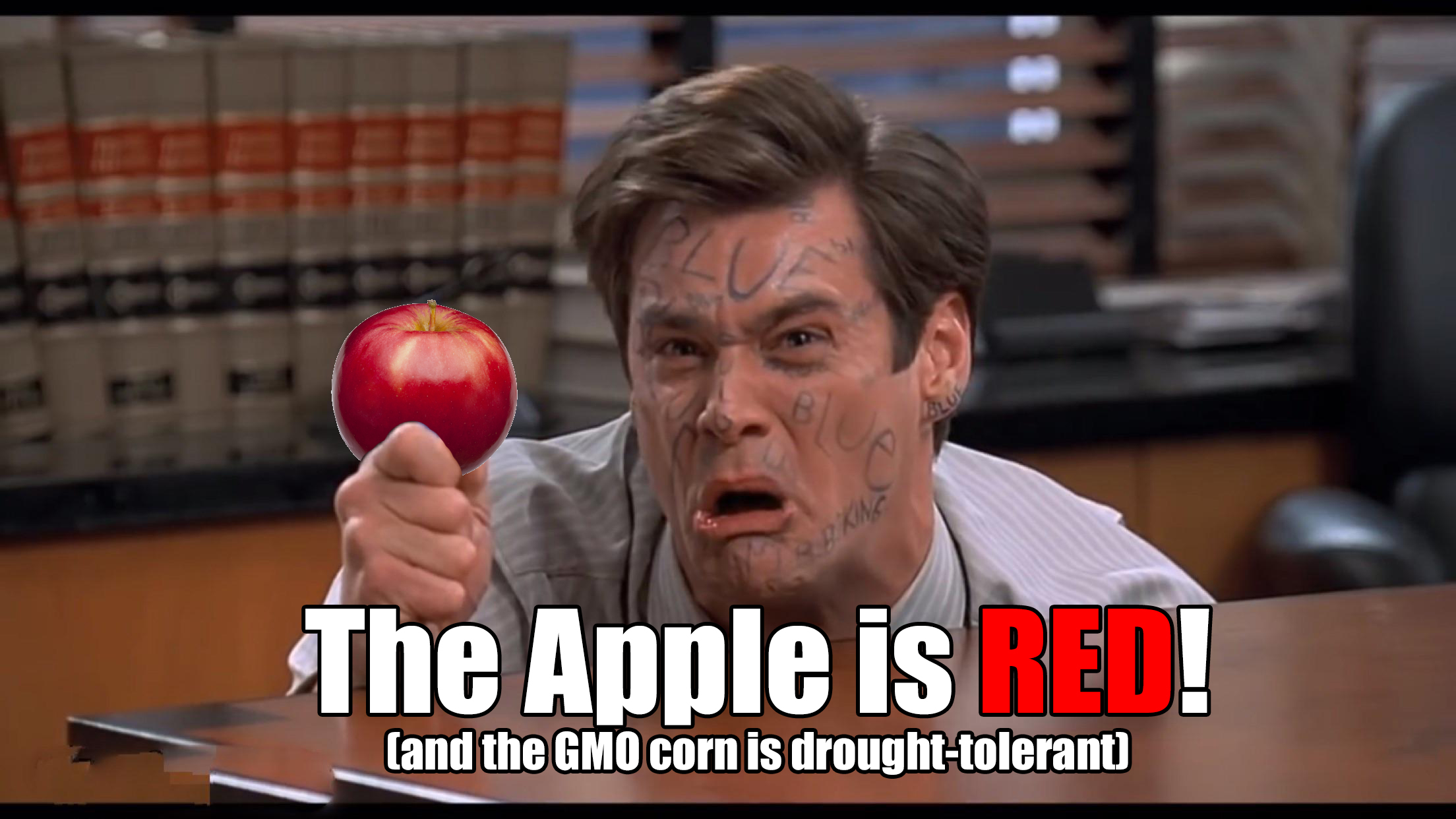
Other statements by Spector were worse. She misrepresented the National Academy of Sciences report on GE crops that was published last year, saying that they found that GE crops did not increase yields. The report touched on yield in several places, and stated that they could not conclude that GE crops had increased the rate at which yields were going up, but did in fact state that they had contributed to yield gain. Even Doug Gurian-Sherman, who has worked for CFS, estimated that GE insect-resistant traits had increased yield. Furthermore, Spector said that the industry “failed to produce a commercialized GE crop with enhanced nutritional content.” The Center for Food Safety spends its time suing to stop the approval of every genetically engineered crop that it can, is now complaining that none have come to market? Apparently they missed the approval of high-oleic Plenish soybeans by DuPont Pioneer (see our interview with Susan Knowlton here) and omega-3 fatty acid producing soybeans by Monsanto. I’m sure they just forgot about them.
Rebecca Spector said that the public “should not be given information that is false and misleading” and I wholeheartedly agree.
Consumers Union sides with general safety, argues falsehoods
Elisa Odabashian, representing the Consumer’s Union spoke against “misleading” information about genetically engineered foods. She repeated the same claims about the NAS report and yields, and claimed that GE crops “vastly” increased herbicide use while decreasing insecticide use. She said that Roundup use “increased more than 15 times” but neglected to mention reductions of other herbicides that it replaced, a very common and intentionally misleading statement about pesticide use. Odabashian said that the FDA should only communicate “settled science.” The use of this term seemed very odd, as it has a very specific meaning in political contexts, widely used by opponents of climate change science to undermine its acceptance. She claimed that Golden Rice has stunted growth, citing a poorly-researched blog post that looked at the wrong transgenic event – one that was discontinued 3 years ago. The current Golden Rice variety has already begun the approval process in the Philippines.
Odabasian made some good comments that should be carefully understood by everyone. She said that there is no strong evidence that the GE crops on the market pose safety hazards, although the technology carries some risk. She distanced the Consumer’s Union from the many unsubstantiated claims that genetic engineering is responsible for, such as autism, gluten intolerance, etc. “These claims have been poorly documented, if at all.” These are statements that I agree with. However, the Consumer’s Union has become a source for many of these widespread, unsubstantiated claims. Michael Hansen, a chief scientist working for the organization, has claimed that GE apples might require more pesticides (they don’t), Golden Rice could cause birth defects (it wouldn’t), and a whole host of other claims. I applaud Elisa Odobashian for standing against widespread myths, and daresay that it would be advisable for her organization to take a deeper look into its own role in advancing claims that they are now trying to distance themselves from.
Comments and feedback
I’ll now turn to my own comments delivered during the meeting. As I mentioned previously, Biology Fortified is submitting written comments to the FDA docket to contribute to the information that the FDA has at hand when they put this program together. We could have just submitted them electronically, but I had never participated in this kind of process before. I modified our comments to read them orally, signed up, and hardly slept the night before. I was nervous, but quickly I read our comments, addressing the gaps in public understanding, the need for addressing the issue of safety, farming contexts, and to better explain the FDA’s role in regulating the technology in what’s called the Coordinated Framework. I pointed out that the public needs an independent source for information about nutritionally altered foods and that some FAQ about common questions would be helpful, but advised against addressing every specific claim. I may have spurred many of the anti-consensus claims made by others, but even the Consumer’s Union agreed that evidence of any harm is weak if it even exists.
The FDA also wanted to know where people were getting their information, and how they should go about communicating to the public. Unfortunately, the most easily available information is factually inaccurate, but the upside is that the issue is not deeply polarized. I conveyed a lot of our ideas on how to carry out the outreach, following a “train the trainers” model and using existing networks to get out their message efficiently, rather than reinventing the wheel. I also talked about designing it for social media, and it was these comments that they were particularly interested in. I answered a couple questions about how to go about doing this, who to network with, and we shared a light-hearted moment about how unpredictable and yet so full of potential memes can be.
As a result of the feedback I received, and more ideas that came from the meeting, we’re adding more to our comments to submit them in written form before the deadline. I talked to several of the FDA representatives afterward and they were happy to have our contributions, along with everyone else’s. I’m very glad I went and it was a very valuable experience.
On characters and concerns
The meeting had a few outlandish characters, and its share of genuine concerns expressed about genetically engineered crops. One such character was Mark McAfee, the owner of Organic Pastures Dairy, who quite passionately talked about his personal integrity at length, mounted a defense of raw milk, and attacked the FDA for making his business more difficult. Organic Pastures has been linked to multiple food-borne illness outbreaks such as E. coli, Salmonella, and Campylobacter, some of which have been traced to their products. It got so bad that they started printing labels on their milk bottles talking about their customers’ immune systems as reasons why they could get sick. McAfee spent very little time talking about the issue of the day, but did cap his presentation with saying that the people at the FDA who had been “bought out” had to be rounded up and arrested!
Pamm Larry, from GMO Free California, gave a very disorganized rant that covered everything except her anti-vaccine views. “Why would any critical thinker trust the data?” she said. She complained about why it is considered unethical to demand human studies of GMOs (without any valid hypothesis to test). At the end, she argued that they should instead spend their funds on a scientific study and get Pamela Ronald, Kevin Folta, and Gilles-Eric Seralini in the same room to hammer it out. Her proposal sounded great until she said that the doors should be locked, and 24 hour cameras and bodyguards were necessary! (For whom?) Cooperation across the divide has been repeatedly proposed on our end, and rejected every time. Seralini withdrew from followups to his infamous rat tumor study, so maybe they should have locked the door? Our door is still open.
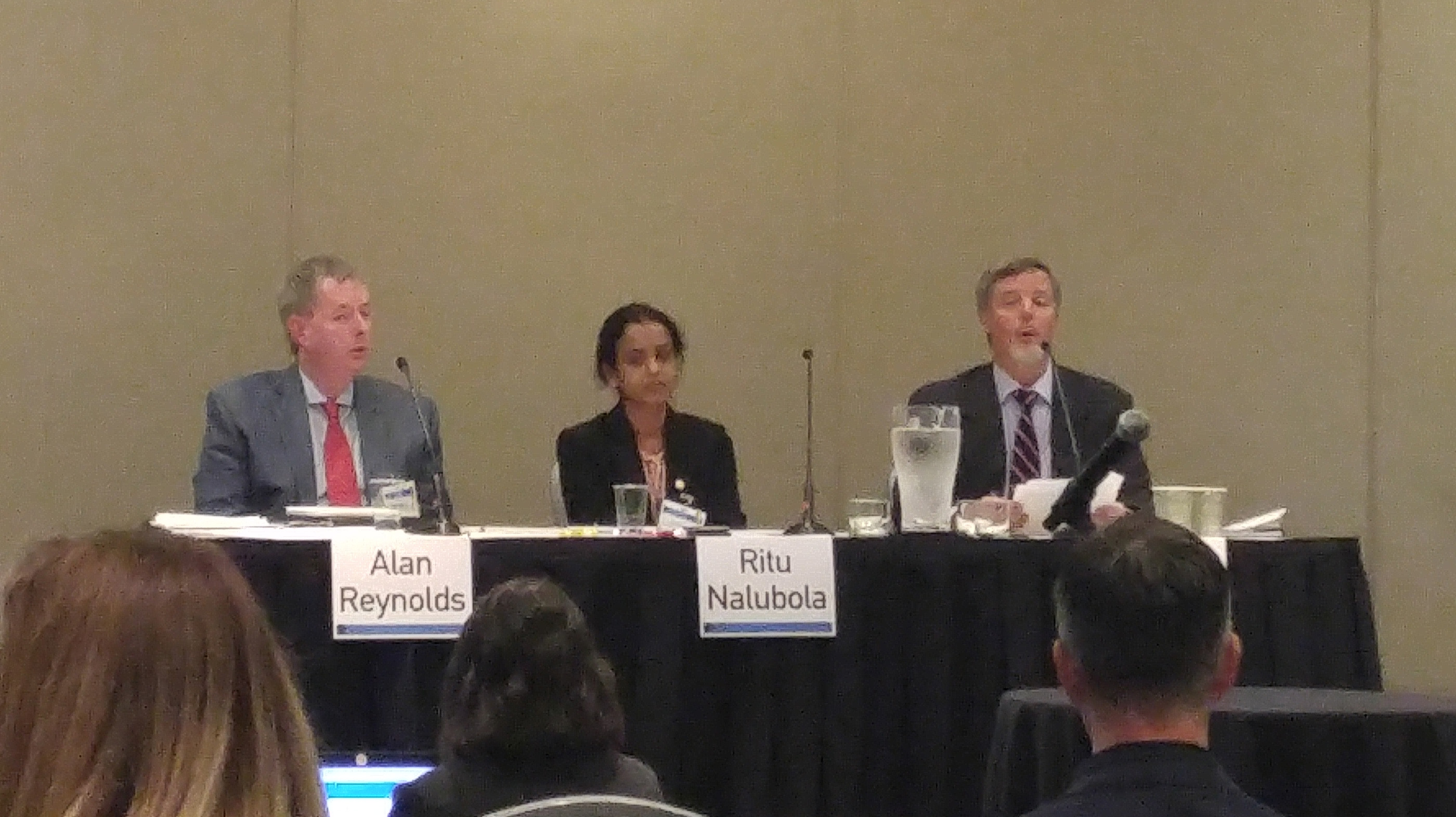
There were many people who expressed general concerns about biotechnology, and the trustworthiness of the companies and the FDA. They didn’t come to speak to the questions the FDA was posing, but to instead show their opposition to the measure, and their desire for a more approachable FDA with a clearer website. Even Mark McAfee got back up and said he wanted a “mommy-friendly FDA.” They wanted to be able to talk to their regulators, and break down the wall of misunderstanding. They wanted the FDA to know they had concerns about their health, and those of their families. The FDA representatives took some time to talk about their own motivations and concerns about their children and their own health. It seemed at times that even those who were deeply suspicious of the FDA were really elated just to be able to meet them face-to-face and understand that everyone in the room is human and wants to be able to connect and understand each other. Perhaps some of the same people who came to the meeting afraid of biotechnology may someday be thankful of future efforts made possible by how they expressed their concerns that day?
Alan Reynolds, one of the three FDA representatives on the stage, said “the most important word today was TRUST.”
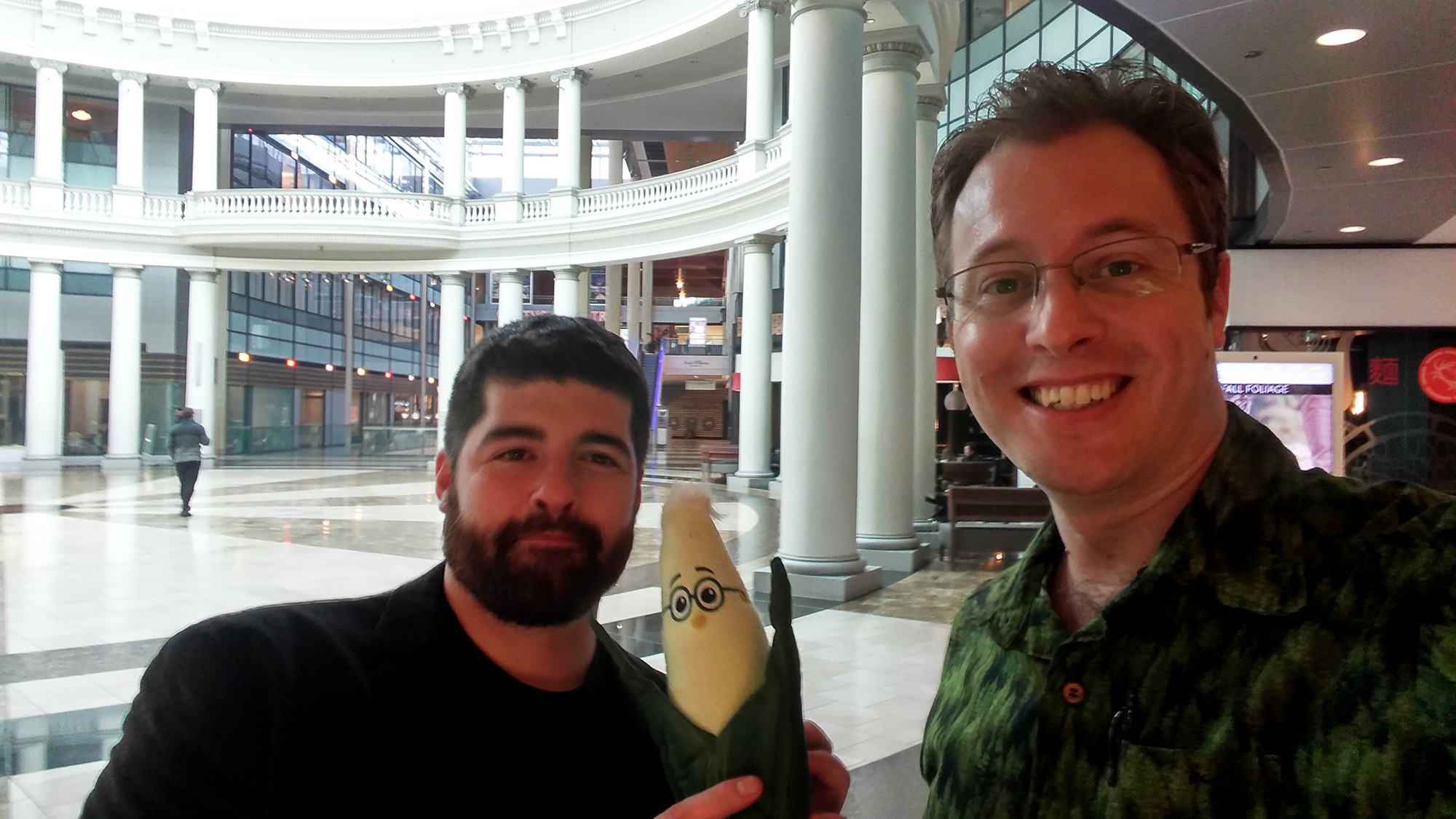
Last day to submit comments!
The FDA docket is about to close, at the end of the day on Friday the 17th – today. If you want to have an impact on this education and outreach initiative, I strongly urge you to answer the FDA’s questions and submit them right now. If you don’t then their only guidance will be what I have described here, their previous meeting in Charlotte NC, and what you see that has already been submitted. Add your voice now – you have until midnight Eastern Standard Time.
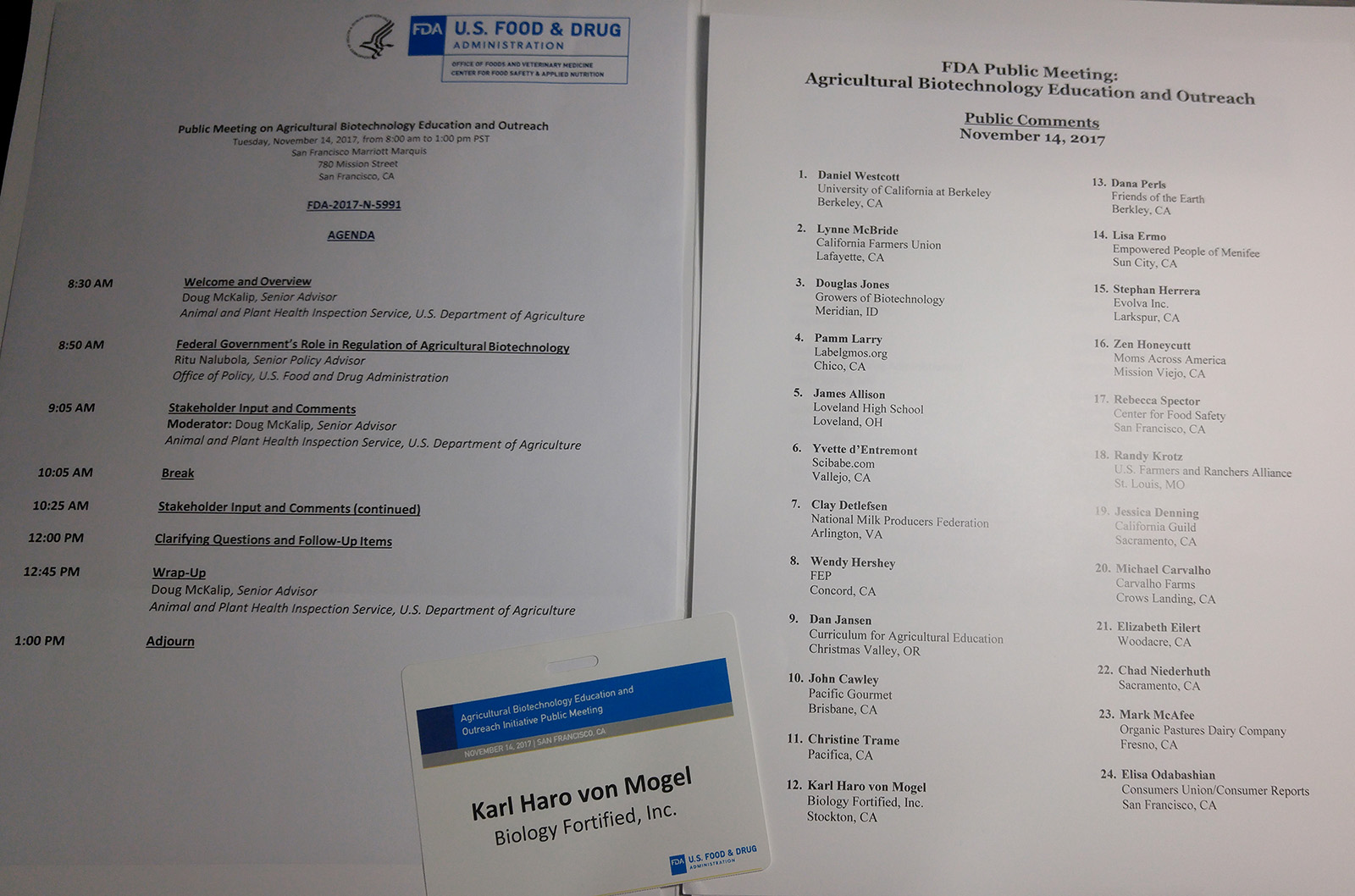
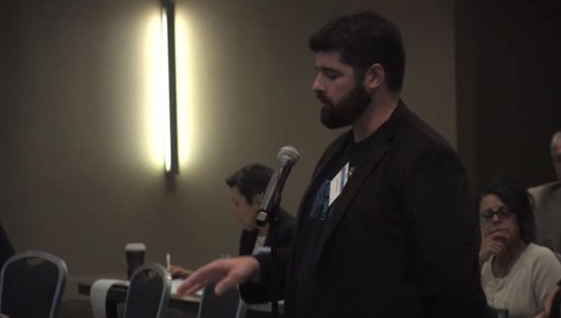

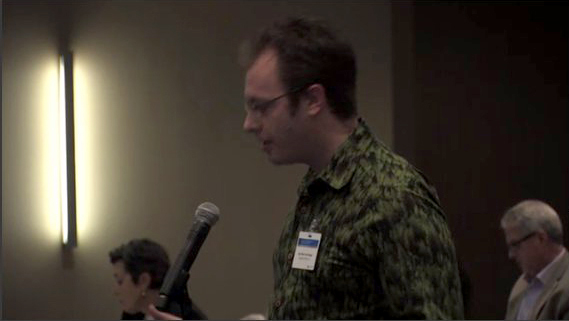
Some examples of other comments, to give you more ideas: Alison van Eenennaam https://www.regulations.gov/document?D=FDA-2017-N-5991-0566
And Val Giddings: https://www.regulations.gov/document?D=FDA-2017-N-5991-0464
LikeLike
Great story. Thanks for your dedication and persistence! Mark McAfee of Organic Pasteurs Dairy, that’s a story I was unaware about.
LikeLike
If only it was Organic PASTEURS Dairy, then there wouldn’t be such a problem!
LikeLike
Nice, Peggy Lemaux is awesome!
LikeLike